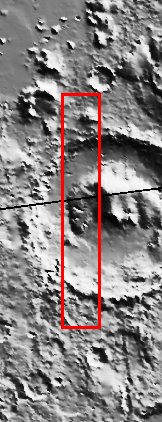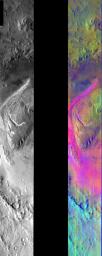
Released August 4, 2004
This image shows two representations of the same infra-red image of Gale Crater. On the left is a grayscale image showing surface temperature, and on the right is a false-color composite made from 3 individual THEMIS bands. The false-color image is colorized using a technique called decorrelation stretch (DCS), which emphasizes the spectral differences between the bands to highlight compositional variations.
In the bottom of the crater, surrounding the central mound, there are extensive basaltic sand deposits. The basaltic sand spectral signature combined with the warm surface (due to the low albedo of basaltic sand) produces a very strong pink/magenta color. This color signature contrasts with the green/yellow color of soil and dust in the top of the image, and the cyan color due to the presence of water ice clouds at the bottom of the image. This migrating sand may be producing the erosional features seen on the central mound.
Image information: IR instrument. Latitude -4.4, Longitude 137.4 East (222.6 West). 100 meter/pixel resolution.
Note: this THEMIS visual image has not been radiometrically nor geometrically calibrated for this preliminary release. An empirical correction has been performed to remove instrumental effects. A linear shift has been applied in the cross-track and down-track direction to approximate spacecraft and planetary motion. Fully calibrated and geometrically projected images will be released through the Planetary Data System in accordance with Project policies at a later time.
NASA's Jet Propulsion Laboratory manages the 2001 Mars Odyssey mission for NASA's Office of Space Science, Washington, D.C. The Thermal Emission Imaging System (THEMIS) was developed by Arizona State University, Tempe, in collaboration with Raytheon Santa Barbara Remote Sensing. The THEMIS investigation is led by Dr. Philip Christensen at Arizona State University. Lockheed Martin Astronautics, Denver, is the prime contractor for the Odyssey project, and developed and built the orbiter. Mission operations are conducted jointly from Lockheed Martin and from JPL, a division of the California Institute of Technology in Pasadena.

 Planetary Data System
Planetary Data System













